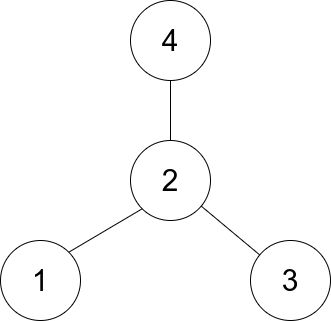有一个无向的 星型 图,由 n 个编号从 1 到 n 的节点组成。星型图有一个 中心 节点,并且恰有 n - 1 条边将中心节点与其他每个节点连接起来。
给你一个二维整数数组 edges ,其中 edges[i] = [ui, vi] 表示在节点 ui 和 vi 之间存在一条边。请你找出并返回 edges 所表示星型图的中心节点。
示例 1:
输入:edges = [[1,2],[2,3],[4,2]] 输出:2 解释:如上图所示,节点 2 与其他每个节点都相连,所以节点 2 是中心节点。
示例 2:
输入:edges = [[1,2],[5,1],[1,3],[1,4]] 输出:1
提示:
3 <= n <= 105edges.length == n - 1edges[i].length == 21 <= ui, vi <= nui != vi- 题目数据给出的
edges表示一个有效的星型图
方法一:直接比较前两条边的点
中心点的特点是,它与其他所有点都相连,因此只要比较前两条边的点,如果有相同的点,那么这个点就是中心点。
时间复杂度
class Solution:
def findCenter(self, edges: List[List[int]]) -> int:
return edges[0][0] if edges[0][0] in edges[1] else edges[0][1]class Solution {
public int findCenter(int[][] edges) {
int a = edges[0][0], b = edges[0][1];
int c = edges[1][0], d = edges[1][1];
return a == c || a == d ? a : b;
}
}function findCenter(edges: number[][]): number {
for (let num of edges[0]) {
if (edges[1].includes(num)) {
return num;
}
}
}class Solution {
public:
int findCenter(vector<vector<int>>& edges) {
int a = edges[0][0], b = edges[0][1];
int c = edges[1][0], d = edges[1][1];
return a == c || a == d ? a : b;
}
};func findCenter(edges [][]int) int {
a, b := edges[0][0], edges[0][1]
c, d := edges[1][0], edges[1][1]
if a == c || a == d {
return a
}
return b
}impl Solution {
pub fn find_center(edges: Vec<Vec<i32>>) -> i32 {
if edges[0][0] == edges[1][0] || edges[0][0] == edges[1][1] {
return edges[0][0];
}
edges[0][1]
}
}/**
* @param {number[][]} edges
* @return {number}
*/
var findCenter = function (edges) {
const [a, b] = edges[0];
const [c, d] = edges[1];
return a == c || a == d ? a : b;
};
